Statistical Analysis of the Interdependence between the Technical and Functional Parameters of Electric Vehicles in the European Market
Abstract
1. Introduction
2. Materials and Methods
2.1. Primary Statistical Analysis
2.2. Multivariate Statistical Correlation Analysis
- A first statistical correlation analysis, in which we wanted to highlight the causal interdependence (causal link) between a series of performance parameters (autonomy, maximum speed, acceleration) and a series of technical parameters (battery capacity, energy efficiency, fast charging speed, weight, electric motor power) of the electric vehicle. The statistical correlation method based on the Pearson correlation coefficient is a technique used to measure the degree of the linear relationship between two continuous variables. The Pearson correlation coefficient is based on the covariance and standard deviation of the two variables and ranges from −1 to +1. The formula used for calculating the Pearson correlation coefficient is:
- rxy is the Pearson correlation coefficient;
- n is the number of observation pairs (sample size);
- xi are the individual values of the x variable;
- yi are the individual values of the y variable;
- is the arithmetic mean of all x values;
- is the arithmetic mean of all y values.
- If rxy = 1, there is a perfect positive relationship between the two variables.
- If rxy = −1, there is a perfect negative relationship between the two variables.
- If rxy is close to 0, there is no linear relationship between the two variables.
- If rxy is positive, then the two variables are positively associated, meaning that if one increases, the other also increases.
- If rxy is negative, then the two variables are negatively associated, meaning that if one increases, the other decreases.
- (a)
- Accuracy: statistical correlation analysis measures the degree of the linear relationship between two variables, which means that it can be used to precisely evaluate the interdependence between the commercial performance of the electric vehicle and its technical parameters. Thus, the prediction model can be highly accurate in estimating the performance of the electric vehicle.
- (b)
- Ease of use: statistical correlation analysis is a metric and simple method that is easy to understand, which makes the prediction model accessible and easy to understand and interpret for specialists in the automotive industry.
- (c)
- Scalability: the prediction model is scalable and can be applied to a wide range of electric vehicles, regardless of their size or performance.
- (d)
- Identification of significant relationships: the model can identify significant relationships between commercial performance and technical parameters, so electric vehicle manufacturers can adjust and make improvements to their vehicle design and specifications to increase their performance and efficiency.
- 2.
- Construction of a causal model and continuous interdependence of the technical and performance parameters of electric vehicles (based on the links/interdependence between them), and model moderated/influenced by customer needs and requests (fast charging and constructive type).
2.2.1. Research Hypotheses
2.2.2. Data Analysis and Interpretation
- 1.
- Hypothesis H1.
- 2.
- Hypothesis H2.
- 3.
- Hypothesis H3.
3. Conclusions
- (1)
- A first level aiming at an interdependence due to market demands (requests) of customers and the performance and technical parameters of electric vehicles. The positive interdependence shows an increase over time of both the performance parameters of electric vehicles (especially in terms of autonomy and acceleration) and the technical parameters (especially related to the fast charging speed).
- (2)
- A second level of interdependence between performance parameters and technical parameters of electric vehicles (positive interdependence). In this case, the greatest interdependence refers to the connection between the autonomy of electric vehicles, vehicle’s curb weight, and energetic capacity of the battery (+0.355 and +0.687, respectively), and between the dynamics of an electric vehicle (acceleration and maximum speed) and the power of the electric motor (+0.633 and +0.661, respectively). The only negative interdependence in the model is between vehicle’s curb weight and energy efficiency (−0.181) (see Figure 20).
- (3)
- A third level of interdependence, with the negative link between the weight and the energy efficiency of electric vehicles, which highlights the need to continue research and the development of new solutions by the automotive industry to improve this problem.
Author Contributions
Funding
Data Availability Statement
Conflicts of Interest
References
- European Environmental Agency. Decarbonising Road Transport—The Role of Vehicles, Fuels and Transport Demand; EEA Report No 2; European Environmental Agency: Copenhagen, Denmark, 2022; Available online: https://www.eea.europa.eu/publications/transport-and-environment-report-2021 (accessed on 24 July 2022).
- Mainka, A.; Żak, M. Synergistic or Antagonistic Health Effects of Long- and Short-Term Exposure to Ambient NO2 and PM2.5: A Review. Int. J. Environ. Res. Public Health 2022, 19, 14079. [Google Scholar] [CrossRef] [PubMed]
- Lee, J.; Costello, S.; Balmes, J.R.; Holm, S.M. The Association between Ambient PM2.5 and Low Birth Weight in California. Int. J. Environ. Res. Public Health 2022, 19, 13554. [Google Scholar] [CrossRef] [PubMed]
- Sechel, I.C.; Mariasiu, F. Efficiency of Governmental Policy and Programs to Stimulate the Use of Low-Emission and Electric Vehicles: The Case of Romania. Sustainability 2022, 14, 45. [Google Scholar] [CrossRef]
- Wang, Y.; Wen, Y.; Xu, Y.; Shi, L.; Yang, X. Health Benefits Quantification for New-Energy Vehicles Promotion: A Case Study of Beijing. Int. J. Environ. Res. Public Health 2022, 19, 13876. [Google Scholar] [CrossRef]
- Tornatore, C.; Marchitto, L. Advanced Technologies for the Optimization of Internal Combustion Engines. Appl. Sci. 2021, 11, 10842. [Google Scholar] [CrossRef]
- Burnete, N.V.; Mariasiu, F.; Depcik, C.; Barabas, I.; Moldovanu, D. Review of thermoelectric generation for internal combustion engine waste heat recovery. Prog. Energy Combust. Sci. 2022, 91, 101009. [Google Scholar] [CrossRef]
- Ximinis, J.; Massaguer, A.; Massaguer, E. NOx Emissions below the Prospective EURO VII Limit on a Retrofitted Heavy-Duty Vehicle. Appl. Sci. 2022, 12, 1189. [Google Scholar] [CrossRef]
- Houache, M.S.E.; Yim, C.-H.; Karkar, Z.; Abu-Lebdeh, Y. On the Current and Future Outlook of Battery Chemistries for Electric Vehicles—Mini Review. Batteries 2022, 8, 70. [Google Scholar] [CrossRef]
- Andre, D.; Kim, S.-J.; Lamp, P.; Lux, S.F.; Maglia, F.; Paschos, O.; Stiaszny, B. Future generations of cathode materials: An automotive industry perspective. J. Mater. Chem. A 2015, 3, 6709–6732. [Google Scholar] [CrossRef]
- Fang, H. Challenges with the Ultimate Energy Density with Li-ion Batteries. IOP Conf. Ser. Earth Environ. Sci. 2021, 781, 042023. [Google Scholar] [CrossRef]
- Link, S.; Plötz, P. Technical Feasibility of Heavy-Duty Battery-Electric Trucks for Urban and Regional Delivery in Germany—A Real-World Case Study. World Electr. Veh. J. 2022, 13, 161. [Google Scholar] [CrossRef]
- Nykvist, B.; Olsson, O. The feasibility of heavy battery electric trucks. Joule 2021, 5, 901–913. [Google Scholar] [CrossRef]
- Mauler, L.; Dahrendorf, L.; Duffner, F.; Winter, M.; Leker, J. Cost-effective technology choice in a decarbonized and diversified long-haul truck transportation sector: A U.S. case study. J. Energy Storage 2022, 46, 103891. [Google Scholar] [CrossRef]
- Krim, Y.; Sechilariu, M.; Locment, F.; Alchami, A. Global Cost and Carbon Impact Assessment Methodology for Electric Vehicles’PV-Powered Charging Station. Appl. Sci. 2022, 12, 4115. [Google Scholar] [CrossRef]
- Wang, R.; Song, Y.; Xu, H.; Li, Y.; Liu, J. Life Cycle Assessment of Energy Consumption and CO2 Emission from HEV, PHEV and BEV for China in the Past, Present and Future. Energies 2022, 15, 6853. [Google Scholar] [CrossRef]
- Environmental Europe Agency. Greenhouse Gas Emission Intensity of Electricity Generation in Europe. 2020. Available online: https://www.eea.europa.eu/data-and-maps/indicators/overview-of-the-electricity-production-3/assessment (accessed on 26 October 2022).
- Lieutenant, K.; Borissova, A.V.; Mustafa, M.; McCarthy, N.; Iordache, I. Comparison of “Zero Emission” Vehicles with Petrol and Hybrid Cars in Terms of Total CO2 Release—A Case Study for Romania, Poland, Norway and Germany. Energies 2022, 15, 7988. [Google Scholar] [CrossRef]
- Emanovic, M.; Jakara, M.; Baric, D. Challenges and Opportunities for Future BEVs Adoption in Croatia. Sustainability 2022, 14, 8080. [Google Scholar] [CrossRef]
- Manutworakit, P.; Choocharukul, K. Factors Influencing Battery Electric Vehicle Adoption in Thailand—Expanding the Unified Theory of Acceptance and Use of Technology’s Variables. Sustainability 2022, 14, 8482. [Google Scholar] [CrossRef]
- Lévay, P.Z.; Drossinos, Y.; Thiel, C. The effect of fiscal incentives on market penetration of electric vehicles: A pairwise comparison of total cost of ownership. Energy Policy 2017, 105, 524–533. [Google Scholar] [CrossRef]
- Ling, Z.; Cherry, C.R.; Wen, Y. Determining the Factors That Influence Electric Vehicle Adoption: A Stated Preference Survey Study in Beijing, China. Sustainability 2021, 13, 11719. [Google Scholar] [CrossRef]
- Kim, M.K.; Oh, J.; Park, J.H.; Joo, C. Perceived value and adoption intention for electric vehicles in Korea: Moderating effects of environmental traits and government supports. Energy 2017, 159, 799–809. [Google Scholar] [CrossRef]
- Yang, C.; Tu, J.C.; Jiang, Q. The Influential Factors of Consumers’ Sustainable Consumption: A Case on Electric Vehicles in China. Sustainability 2020, 12, 3496. [Google Scholar] [CrossRef]
- Wróblewski, P.; Lewicki, W. A Method of Analyzing the Residual Values of Low-Emission Vehicles Based on a Selected Expert Method Taking into Account Stochastic Operational Parameters. Energies 2021, 14, 6859. [Google Scholar] [CrossRef]
- Novotny, A.; Szeberin, I.; Kovács, S.; Máté, D. National Culture and the Market Development of Battery Electric Vehicles in 21 Countries. Energies 2022, 15, 1539. [Google Scholar] [CrossRef]
- Sendek-Matysiak, E.; Pyza, D.; Łosiewicz, Z.; Lewicki, W. Total Cost of Ownership of Light Commercial Electrical Vehicles in City Logistics. Energies 2022, 15, 8392. [Google Scholar] [CrossRef]
- Pang, H.; Zhang, F. Experimental Data-Driven Parameter Identification and State of Charge Estimation for a Li-Ion Battery Equivalent Circuit Model. Energies 2018, 11, 1033. [Google Scholar] [CrossRef]
- Celik, B.; Sandt, R.; dos Santos, L.C.P.; Spatschek, R. Prediction of Battery Cycle Life Using Early-Cycle Data, Machine Learning and Data Management. Batteries 2022, 8, 266. [Google Scholar] [CrossRef]
- Yuan, J.; Qin, Z.; Huang, H.; Gan, X.; Li, S.; Li, B. State of Health Estimation and Remaining Useful Life Prediction for a Lithium-Ion Battery with a Two-Layer Stacking Regressor. Energies 2023, 16, 2313. [Google Scholar] [CrossRef]
- Domalanta, M.R.B.; Paraggua, J.A.D.R. A Multiphysics Model Simulating the Electrochemical, Thermal, and Thermal Runaway Behaviors of Lithium Polymer Battery. Energies 2023, 16, 2642. [Google Scholar] [CrossRef]
- Qiang, H.; Hu, Y.; Tang, W.; Zhang, X. Research on Optimization Strategy of Battery Swapping for Electric Taxis. Energies 2023, 16, 2296. [Google Scholar] [CrossRef]
- Soontornnon, N.; Kimata, Y.; Tominaga, Y. Improvement of the Electrode–Electrolyte Interface Using Crosslinked Carbonate-Based Copolymers for Solid-State Lithium-Ion Batteries. Batteries 2022, 8, 273. [Google Scholar] [CrossRef]
- Sangeetha, E.; Ramachandran, V. Different Topologies of Electrical Machines, Storage Systems, and Power Electronic Converters and Their Control for Battery Electric Vehicles—A Technical Review. Energies 2022, 15, 8959. [Google Scholar] [CrossRef]
- Glucina, M.; Andelic, N.; Lorencin, I.; Car, Z. Estimation of Excitation Current of a Synchronous Machine Using Machine Learning Methods. Computers 2023, 12, 1. [Google Scholar] [CrossRef]
- Al-Gabalawy, M.; Elmetwaly, A.H.; Younis, R.A.; Omar, A.I. Temperature prediction for electric vehicles of permanent magnet synchronous motor using robust machine learning tools. J. Ambient. Intell. Humaniz. Comput. 2022. [Google Scholar] [CrossRef]
- Thi, M.T.; Kim, C.; Kwon, S.; Kang, H.; Ko, J.M.; Kim, J.; Choi, W. Investigation of the Properties of Anode Electrodes for Lithium–Ion Batteries Manufactured Using Cu, and Si-Coated Carbon Nanowall Materials. Energies 2023, 16, 1935. [Google Scholar] [CrossRef]
- Li, T.; An, J.; Zhang, D.; Diao, X.; Liu, C.; Liu, W. Research on Interval Optimal Scheduling Strategy of Virtual Power Plants with Electric Vehicles. World Electr. Veh. J. 2022, 13, 235. [Google Scholar] [CrossRef]
- Savari, G.F.; Sathik, M.J.; Raman, L.A.; El-Shahat, A.; Hasanien, H.M.; Almakhles, D.; Aleem, S.H.; Omar, A.I. Assessment of charging technologies, infrastructure and charging station recommendation schemes of electric vehicles: A review. Ain Shams Eng. J. 2023, 14, 101938. [Google Scholar] [CrossRef]
- Mohammed, S.S.; Ahamed, T.P.I.; Aleem, S.H.E.A.; Omar, A.I. Interruptible charge scheduling of plug-in electric vehicle to minimize charging cost using heuristic algorithm. Electr. Eng. 2022, 104, 1425–1440. [Google Scholar] [CrossRef]
- Awad, M.; Ibrahim, A.M.; Alaas, Z.M.; El-Shahat, A.; Omar, A.I. Design and analysis of an efficient photovoltaic energy-powered electric vehicle charging station using perturb and observe MPPT algorithm. Front. Energy Res. 2022, 10, 969482. [Google Scholar] [CrossRef]
- Sebastián, R. Improved Operation and Stability of a Wind-Hydro Microgrid by Means of a Li-Ion Battery Energy Storage. Energies 2022, 15, 9230. [Google Scholar] [CrossRef]
- Rahman, A.; Myo Aung, K.; Ihsan, S.; Raja Ahsan Shah, R.M.; Al Qubeissi, M.; Aljarrah, M.T. Solar Energy Dependent Supercapacitor System with ANFIS Controller for Auxiliary Load of Electric Vehicles. Energies 2023, 16, 2690. [Google Scholar] [CrossRef]
- EV Specifications—Specifications, News and Comparisons. Available online: https://www.evspecifications.com/ (accessed on 1 May 2022).
- Electric Vehicle Database. Available online: https://ev-database.org (accessed on 1 May 2022).
- Ultimate SPECS. Available online: https://www.ultimatespecs.com/car-specs/ (accessed on 1 May 2022).
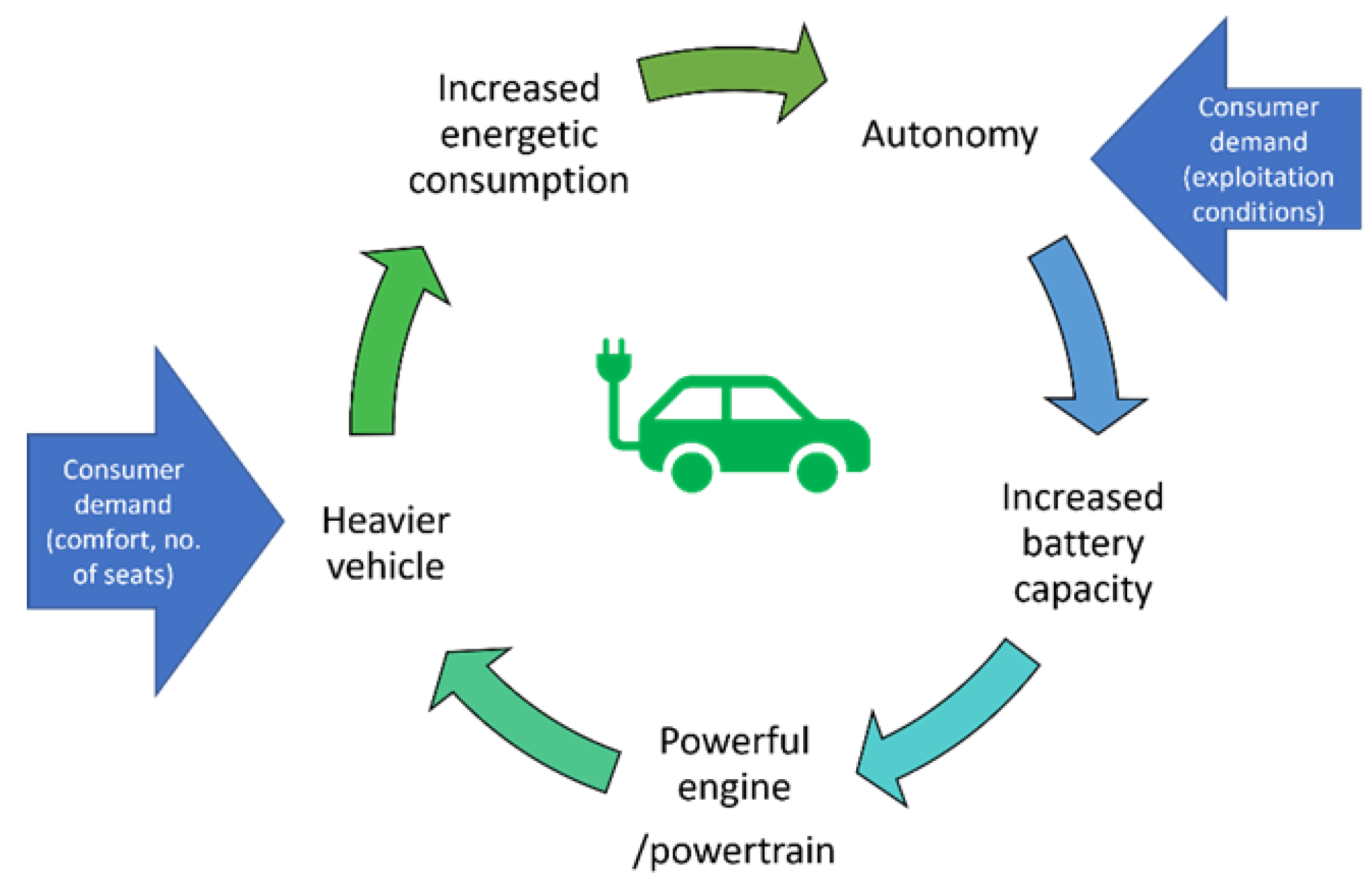


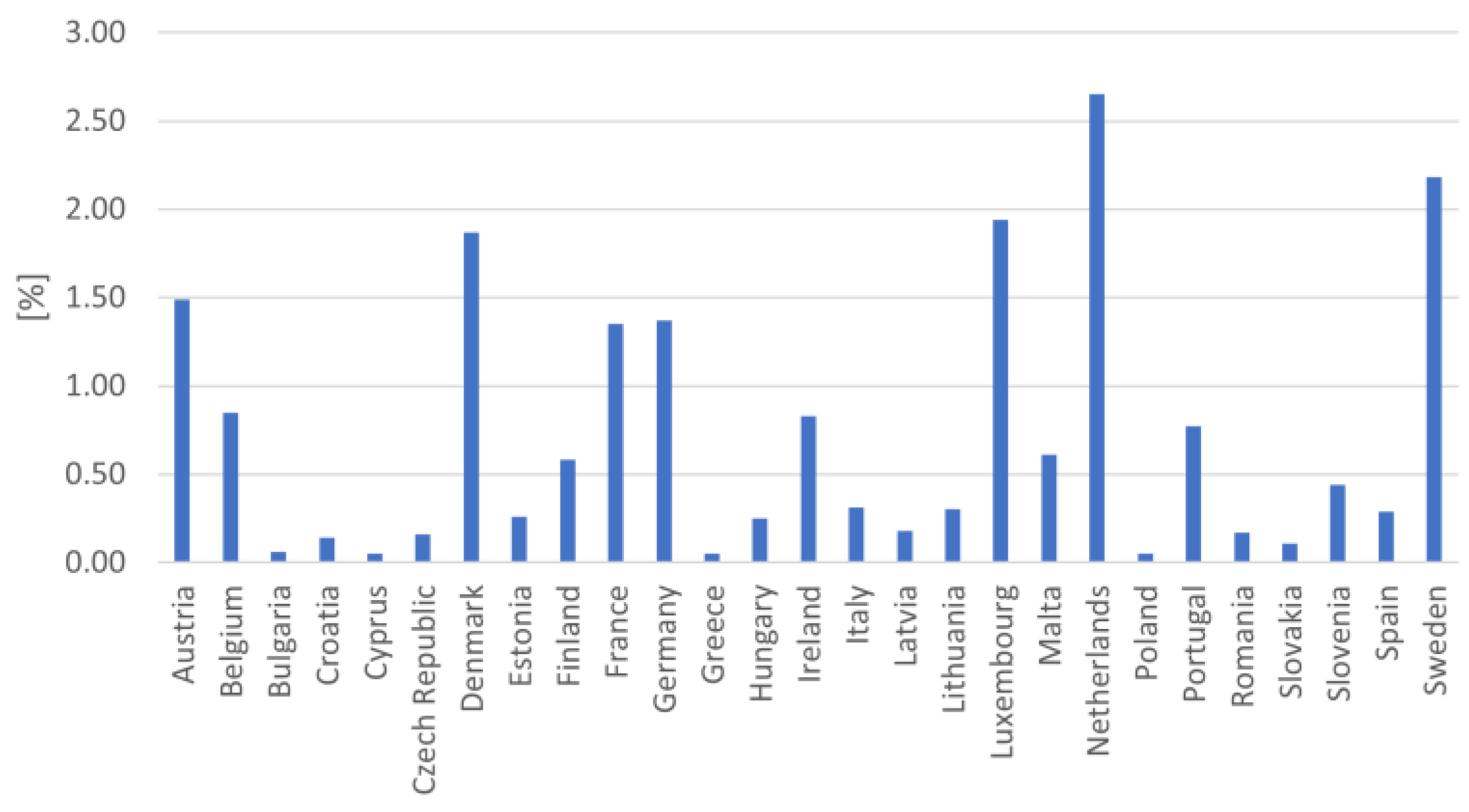
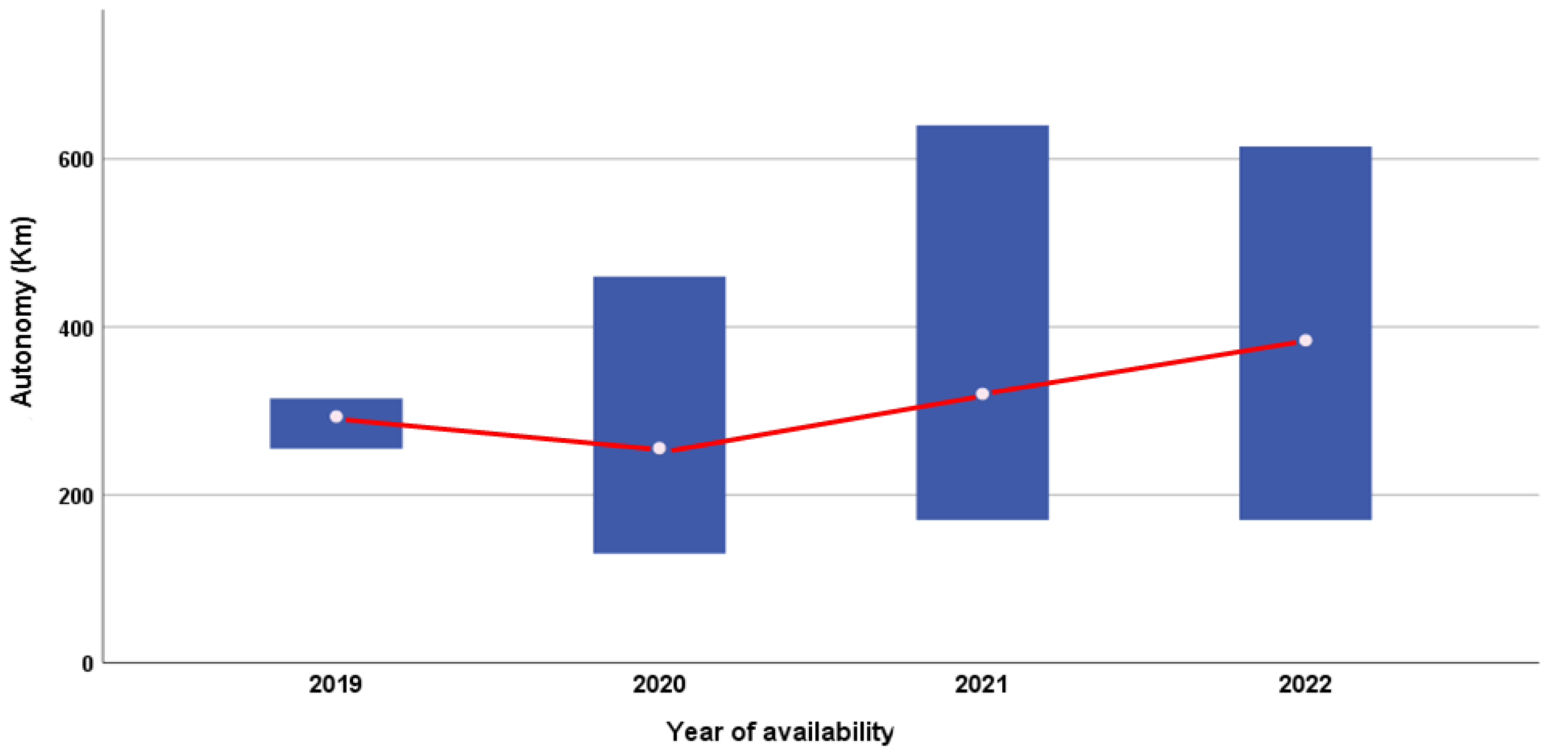


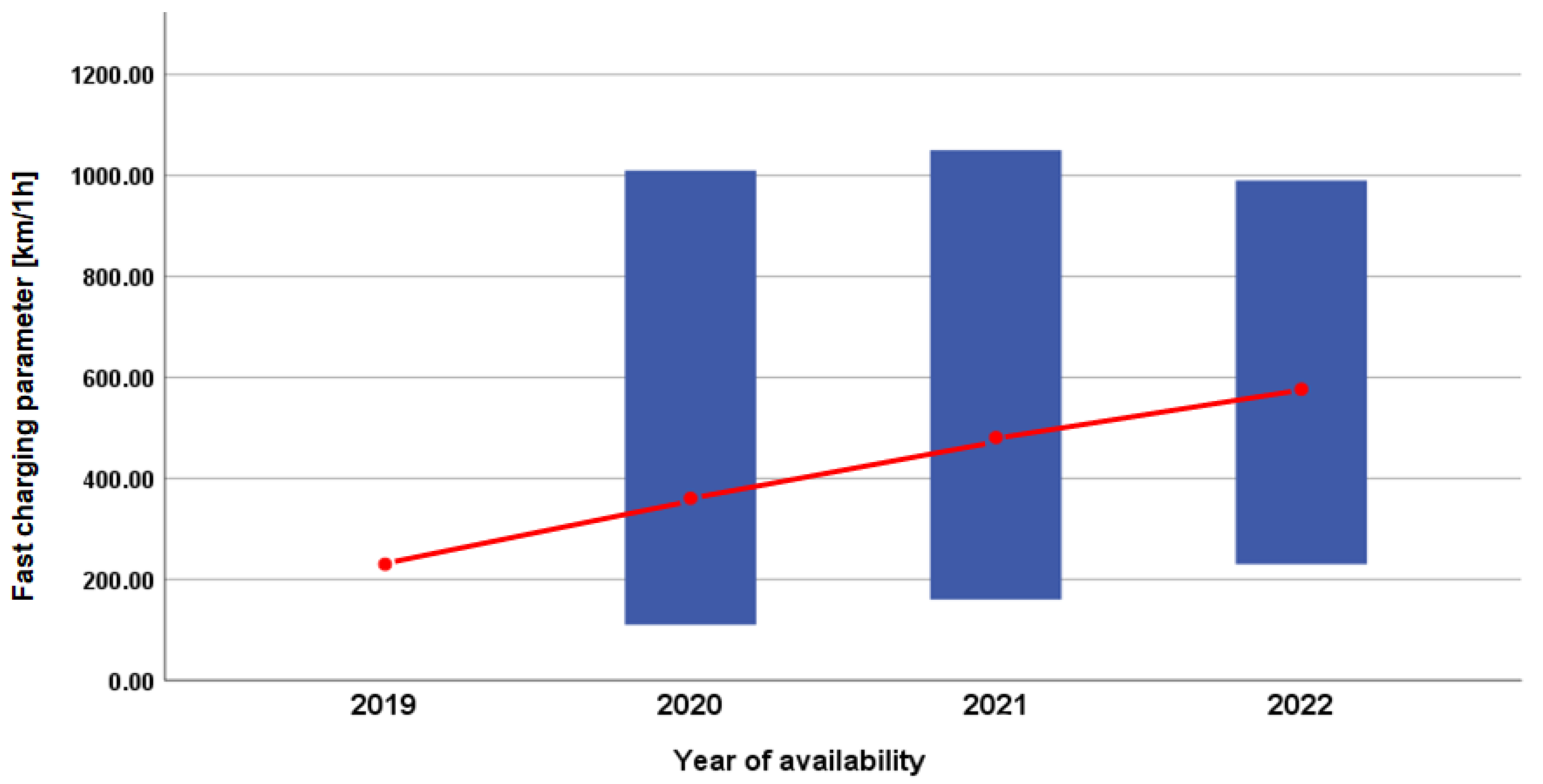
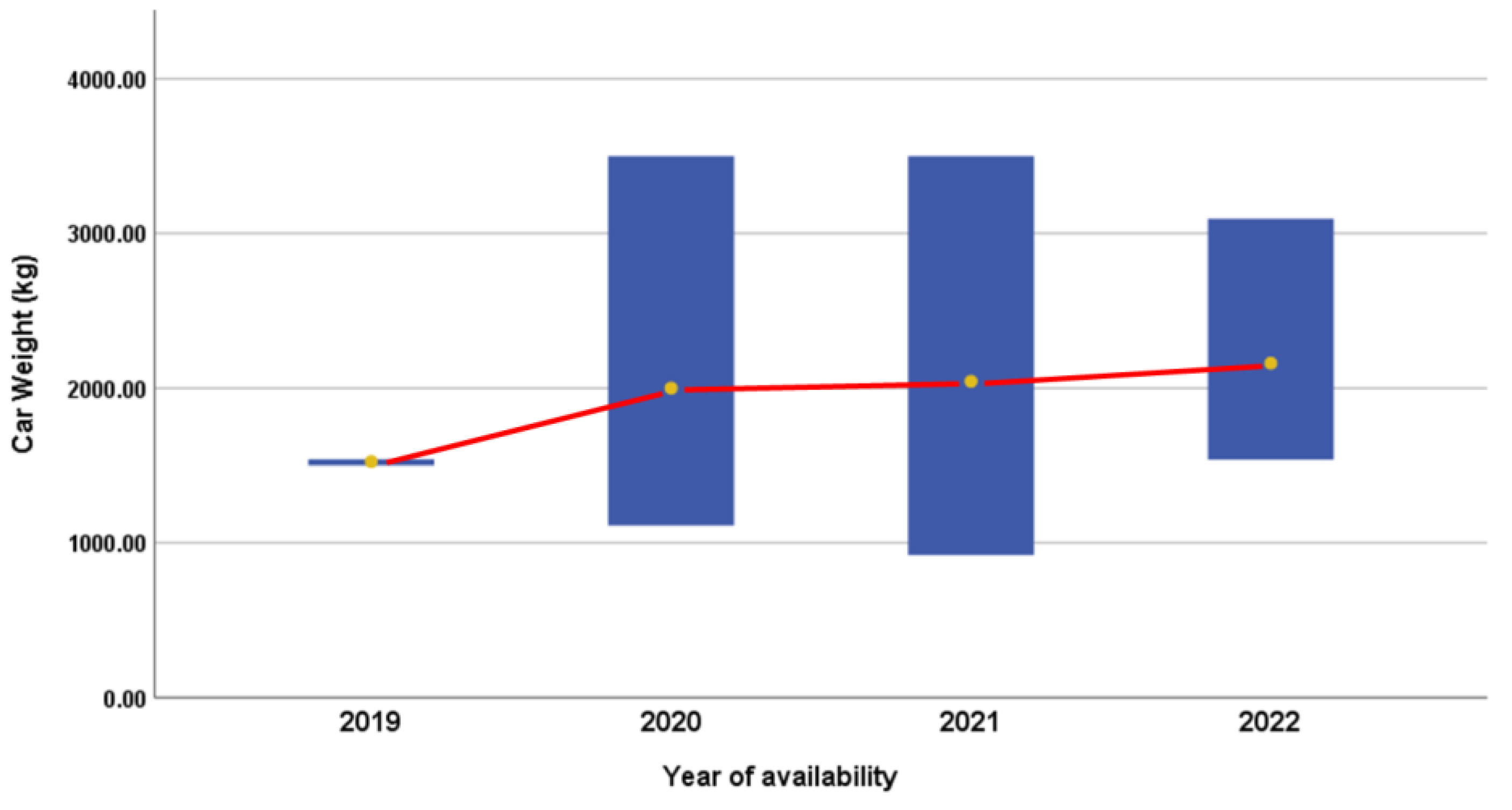
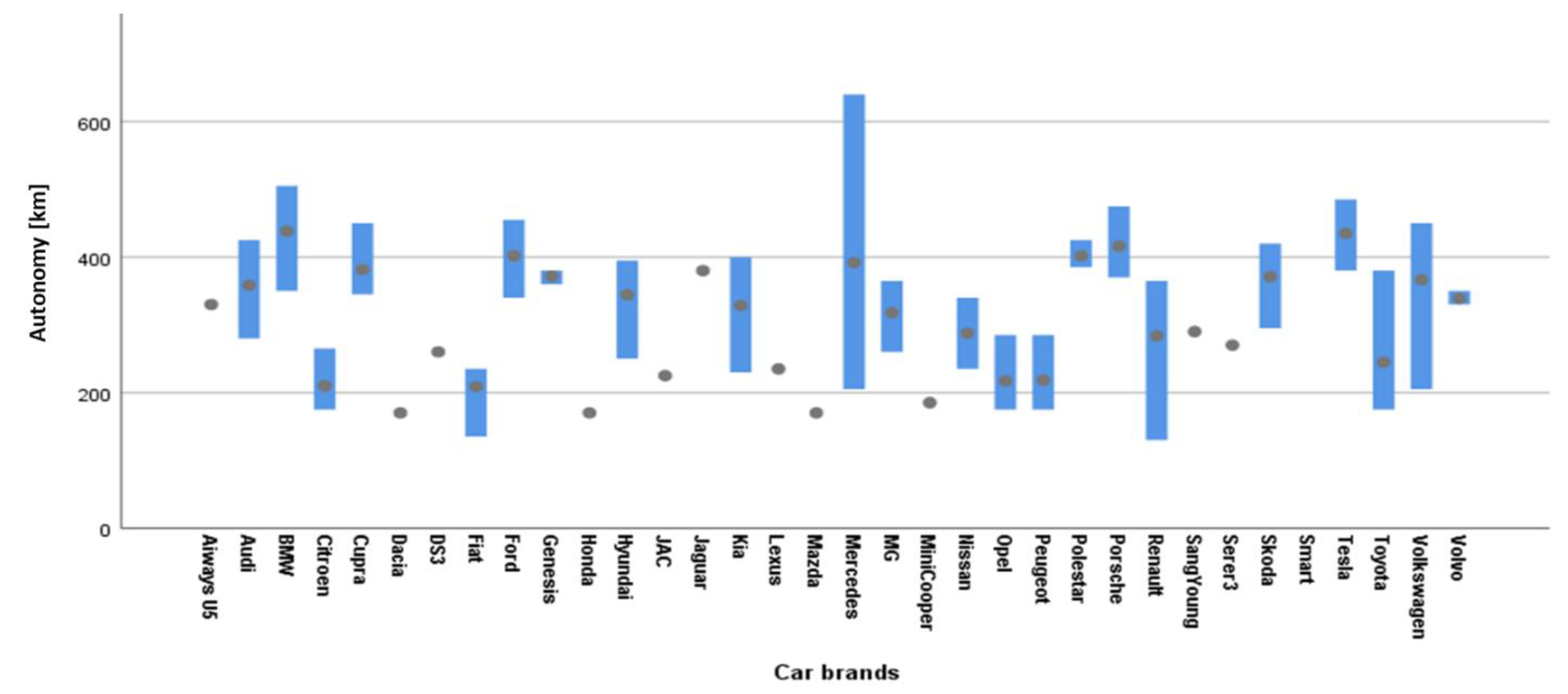
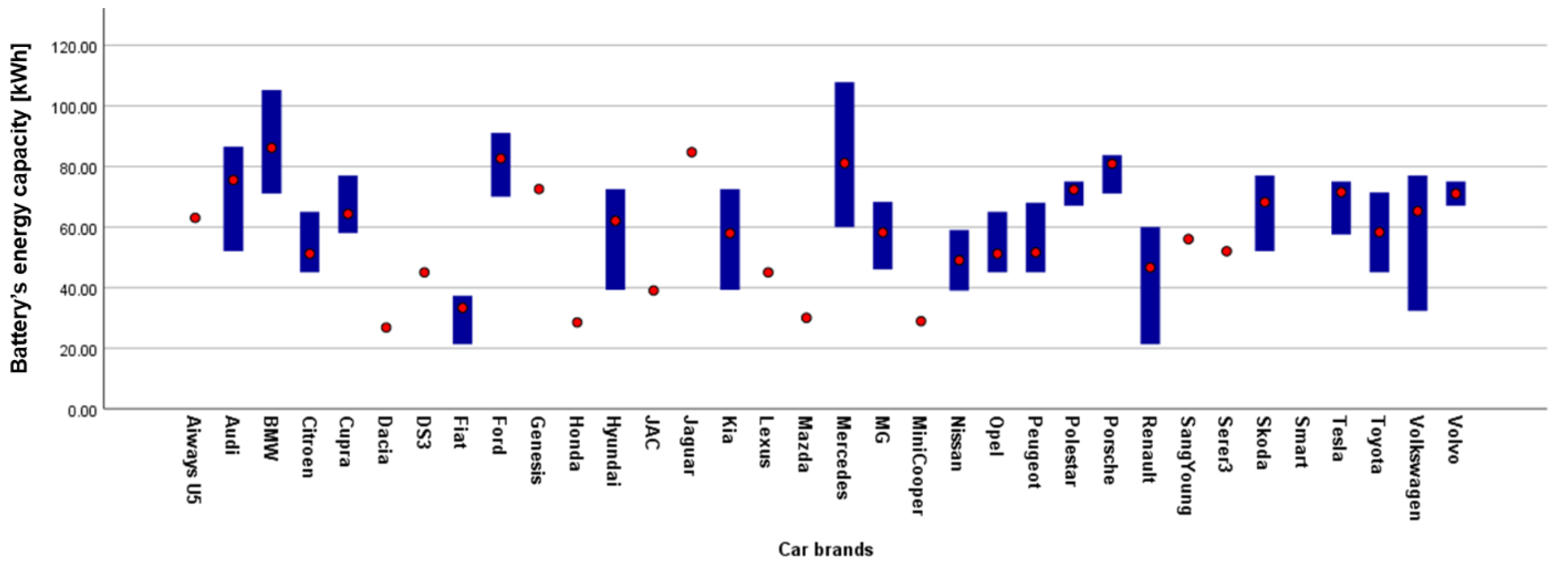

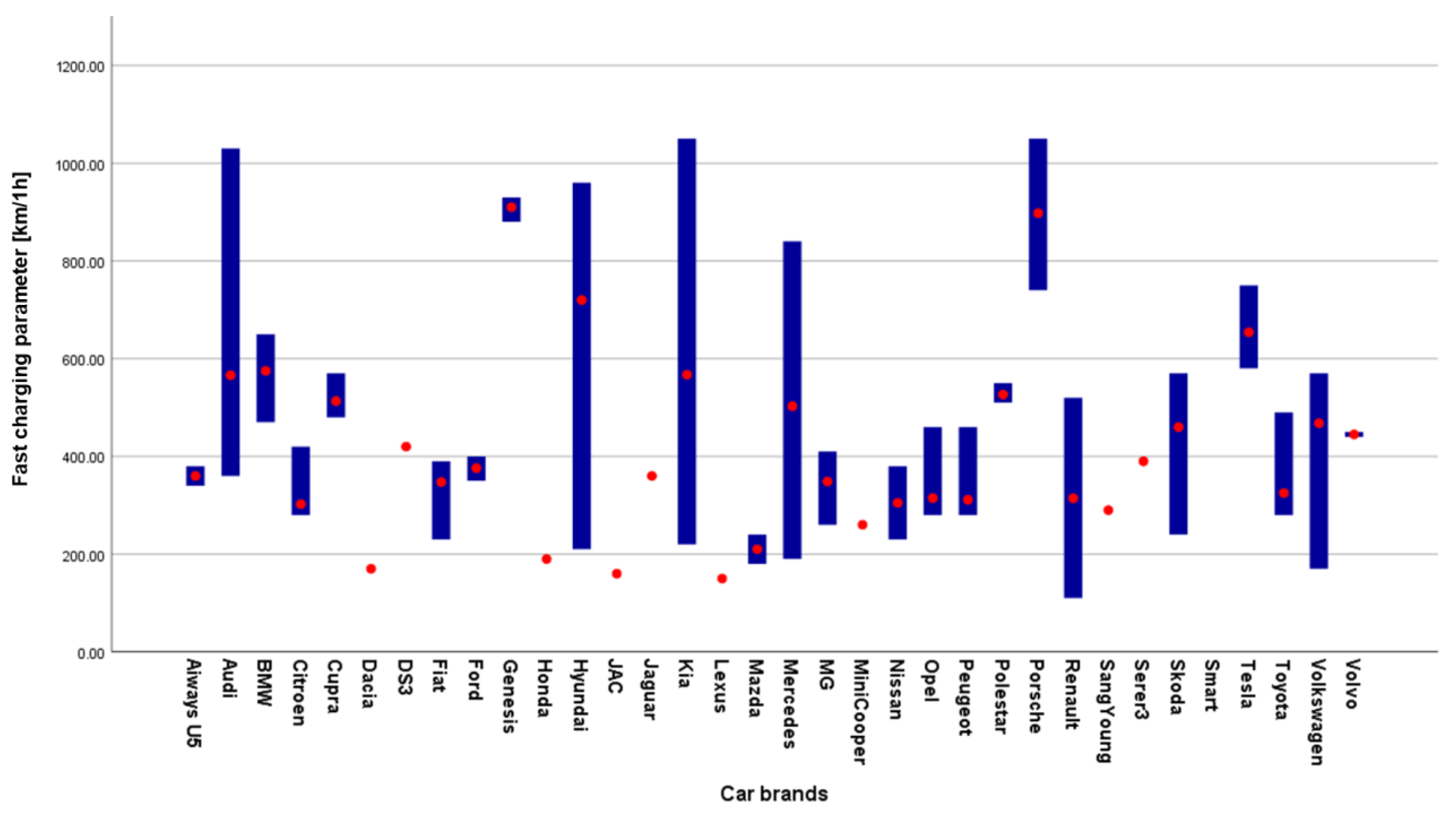

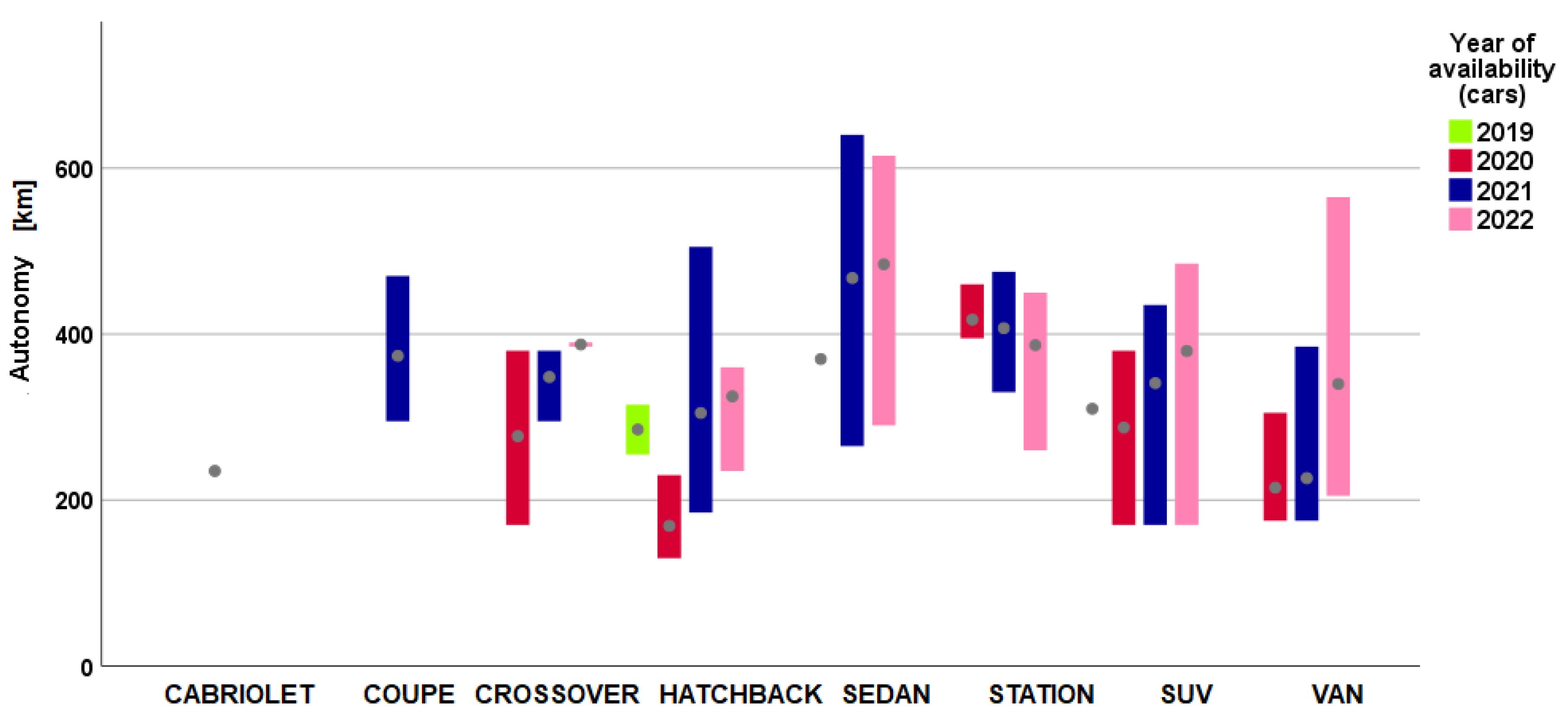
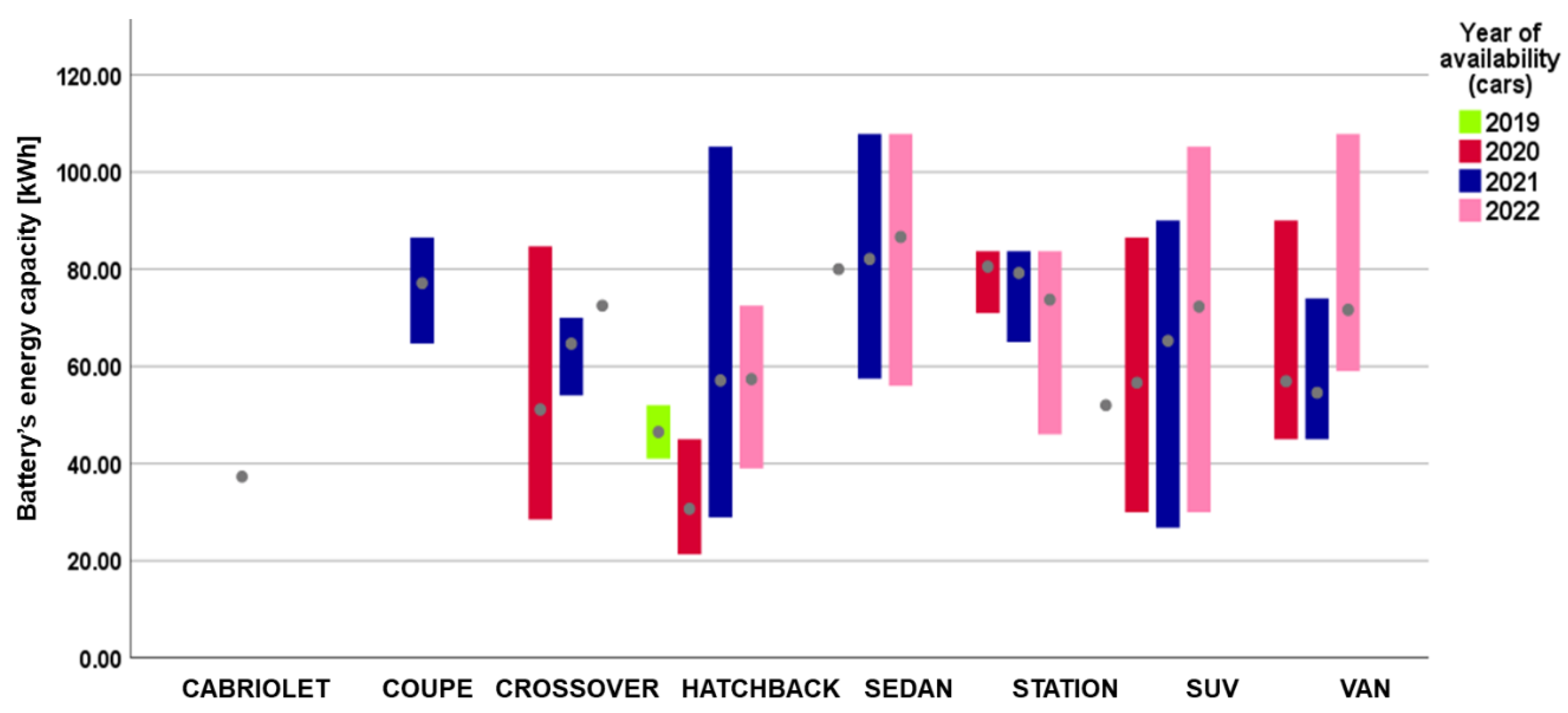
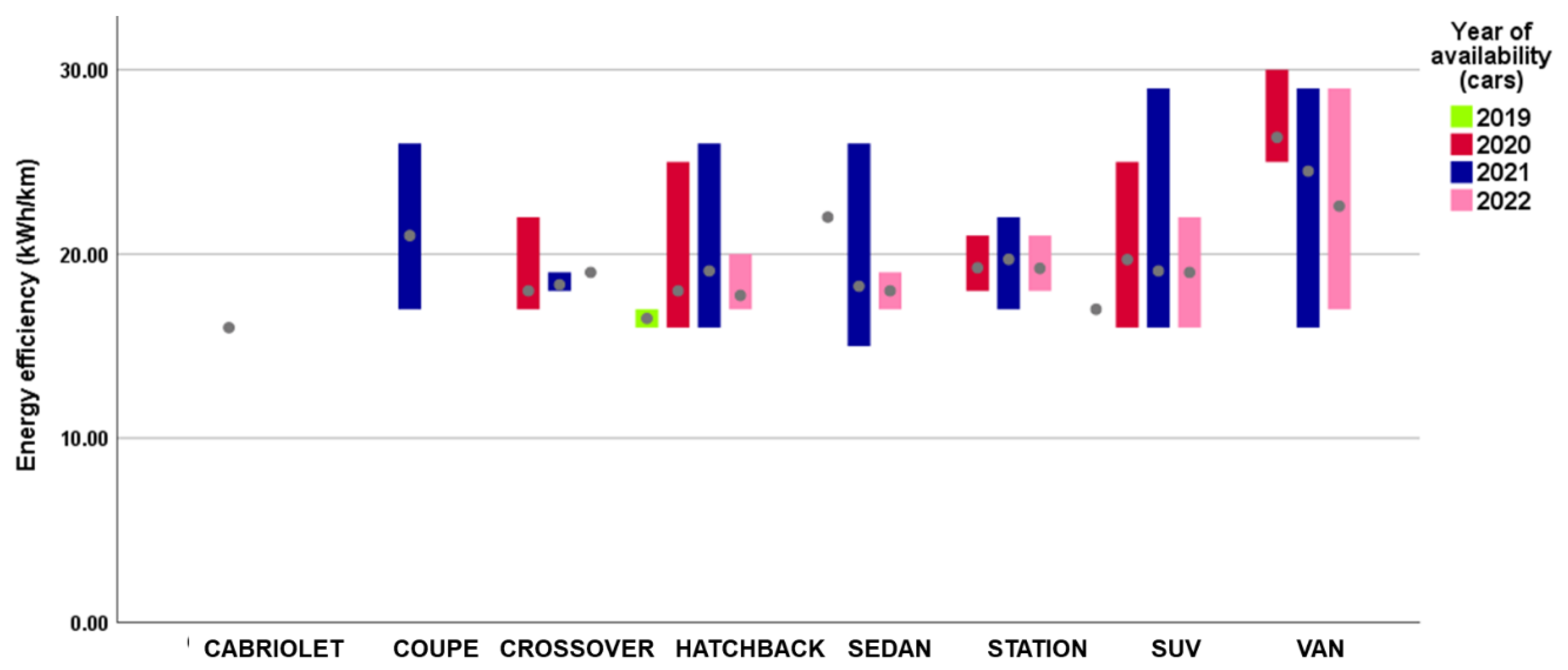

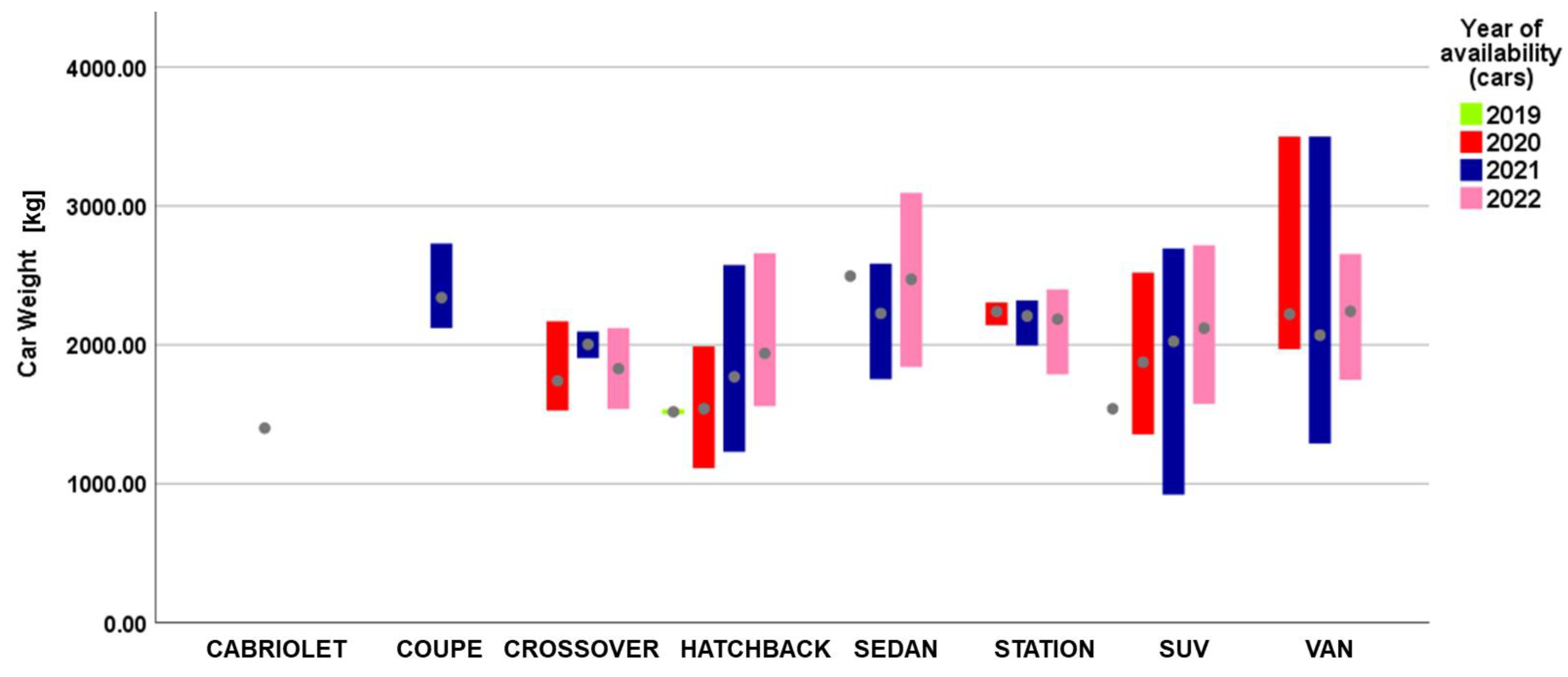
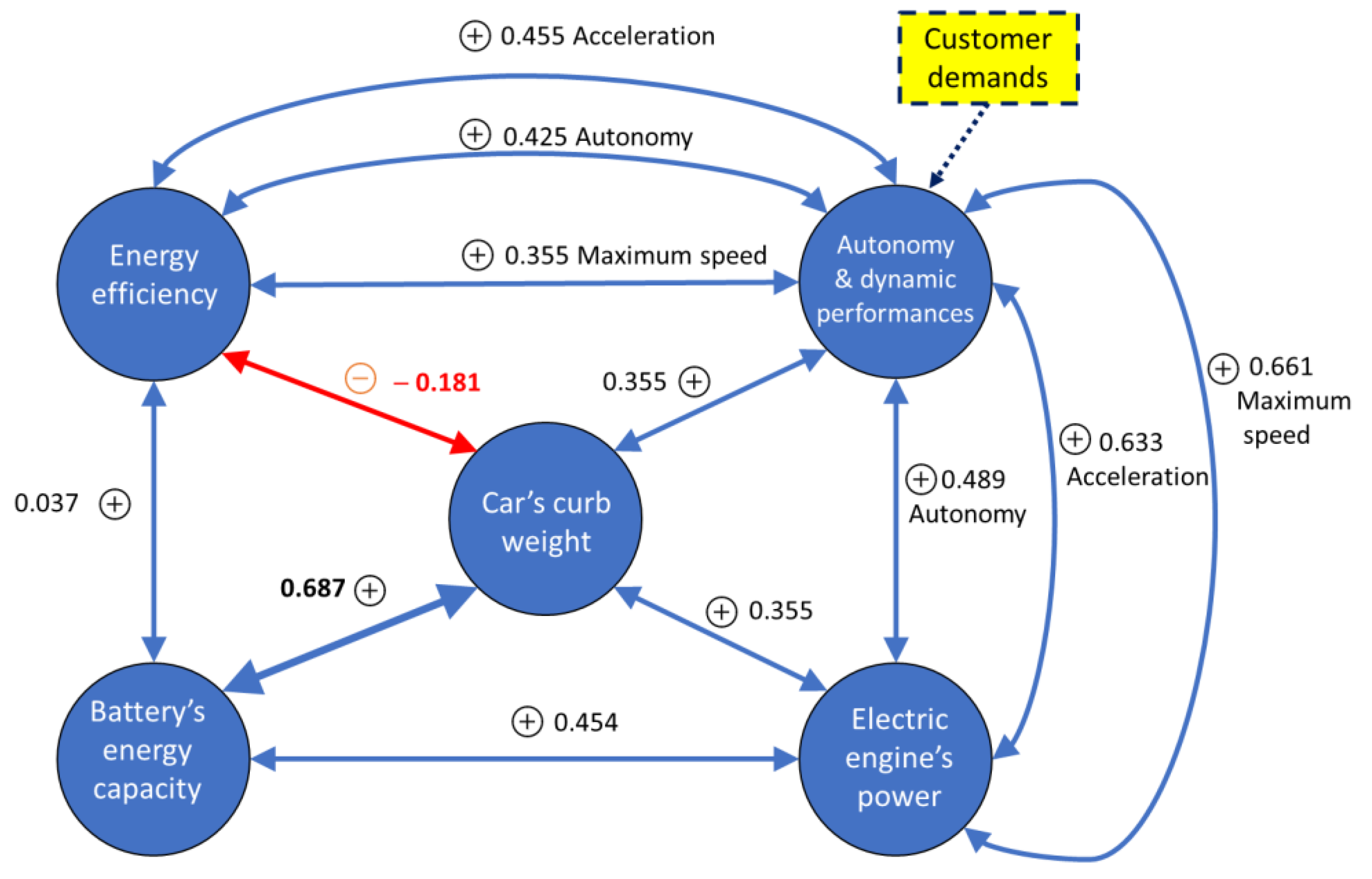
| Direction of Study | Topics | Ref. |
|---|---|---|
| Consumer attitudes |
| [19] |
| [20] | |
| [22] | |
| [23] | |
| [24] | |
| Barriers to integration |
| [21] |
| [25] | |
| [26] | |
| [27] | |
| Energy efficiency of battery |
| [28] |
| [29] | |
| [30] | |
| [31] | |
| [32] | |
| EV components |
| [33] |
| [34] | |
| [35] | |
| [36] | |
| [37] | |
| Integration in power grids |
| [38] |
| [39] | |
| [40] | |
| Use of sustainable energy |
| [41] |
| [42] | |
| [43] |
| Type/Class | Frequency | Percentage (%) | Cumulative Percentage (%) |
|---|---|---|---|
| Hatchback | 29 | 14.3 | 14.3 |
| Coupe | 4 | 2.0 | 16.3 |
| Sedan | 11 | 5.4 | 21.7 |
| Cabriolet | 1 | 0.5 | 22.2 |
| Sport Utility Vehicle | 77 | 37.9 | 60.1 |
| Crossover | 10 | 4.9 | 65.0 |
| Van | 51 | 25.1 | 90.1 |
| Station | 20 | 9.9 | 100.0 |
| Total | 203 | 100.0 | - |
| Parameter | Class 1 | Class 2 | Class 3 | Class 4 |
|---|---|---|---|---|
| Battery energy capacity (kWh) | <27 | 28–54 | 55–80 | >80 |
| Fast charging speed (km/1 h) | 100–300 | 301–600 | 601–900 | >900 |
| Electric engine power (kW) | <150 | 151–250 | 251–350 | >350 |
| Energy efficiency (kWh/km) | >27 | 22–27 | 16–21 | 10–15 |
| Car weight (kg) | <1500 | 1501–2000 | 2001–2500 | >2500 |
| Maximum speed (km/h) | <130 | 131–180 | 181–230 | >230 |
| Acceleration (m/s2) | >12.0 | 8.1–12.0 | 4.1–8.0 | <4.0 |
| Autonomy (km) | <150 | 151–300 | 301–450 | >451 |
| Parameter | Autonomy (km) | Maximum Speed (km/h) | Acceleration (m/s2) | |
|---|---|---|---|---|
| Battery energy capacity (kWh) | Pearson Correlation | 0.606 ** | 0.434 ** | 0.462 ** |
| Sig. (2-tailed) | 0.000 | 0.000 | 0.000 | |
| N | 203 | 203 | 203 | |
| Energetic efficiency (Wh/km) | Pearson Correlation | 0.425 ** | 0.359 ** | 0.455 ** |
| Sig. (2-tailed) | 0.000 | 0.000 | 0.000 | |
| N | 203 | 203 | 203 | |
| Electric engine power (kW) | Pearson Correlation | 0.489 ** | 0.661 ** | 0.633 ** |
| Sig. (2-tailed) | 0.000 | 0.000 | 0.000 | |
| N | 203 | 203 | 203 | |
| Fast charging speed (km/1 h) | Pearson Correlation | 0.401 ** | 0.409 ** | 0.425 ** |
| Sig. (2-tailed) | 0.000 | 0.000 | 0.000 | |
| N | 203 | 203 | 203 | |
| Car weight (kg) | Pearson Correlation | 0.518 ** | 0.309 ** | 0.332 ** |
| Sig. (2-tailed) | 0.000 | 0.000 | 0.000 | |
| N | 203 | 203 | 203 | |
| Parameter | Battery Energy Capacity (kWh) | Energy Efficiency (kWh/km) | Electric Engine Power (kW) | Car Weight (kg) | Fast Charging Speed (km/1 h) | |
|---|---|---|---|---|---|---|
| Battery energy capacity (kWh) | Pearson Corr. | 1 | 0.037 | 0.454 ** | 0.687 ** | 0.564 ** |
| Sig. (2-tailed) | 0.597 | 0.000 | 0.000 | 0.000 | ||
| N | 203 | 203 | 203 | 203 | 203 | |
| Energy efficiency (kWh/km) | Pearson Corr. | 0.037 | 1 | 0.299 ** | −0.181 ** | 0.391 ** |
| Sig. (2-tailed) | 0.597 | 0.000 | 0.010 | 0.000 | ||
| N | 203 | 203 | 203 | 203 | 203 | |
| Electric engine power (kW) | Pearson Corr. | 0.454 ** | 0.299 ** | 1 | 0.355 ** | 0.488 ** |
| Sig. (2-tailed) | 0.000 | 0.000 | 0.000 | 0.000 | ||
| N | 203 | 203 | 203 | 203 | 203 | |
| Car weight (kg) | Pearson Corr. | 0.687 ** | −0.181 ** | 0.355 ** | 1 | 0.385 ** |
| Sig. (2-tailed) | 0.000 | 0.010 | 0.000 | 0.000 | ||
| N | 203 | 203 | 203 | 203 | 203 | |
| Fast charging speed (km/1 h) | Pearson Corr. | 0.564 ** | 0.391 ** | 0.488 ** | 0.385 ** | 1 |
| Sig. (2-tailed) | 0.000 | 0.000 | 0.000 | 0.000 | 0.000 | |
| N | 203 | 203 | 203 | 203 | 203 | |
| Years (2019–2022) | ||
|---|---|---|
| Years (2019–2022) | Pearson Correlation | 1 |
| Sig. (2-tailed) | ||
| N | 203 | |
| Autonomy (km) | Pearson Correlation | 0.397 ** |
| Sig. (2-tailed) | 0.000 | |
| N | 203 | |
| Maximum speed (km/h) | Pearson Correlation | 0.297 ** |
| Sig. (2-tailed) | 0.000 | |
| N | 203 | |
| Acceleration (m/s2) | Pearson Correlation | 0.413 ** |
| Sig. (2-tailed) | 0.000 | |
| N | 203 | |
| Years (2019–2022) | ||
|---|---|---|
| Battery energy capacity (kWh) | Pearson Correlation | 0.244 ** |
| Sig. (2-tailed) | 0.000 | |
| N | 203 | |
| Energy efficiency (kWh/km) | Pearson Correlation | 0.325 ** |
| Sig. (2-tailed) | 0.000 | |
| N | 203 | |
| Electric engine power (kW) | Pearson Correlation | 0.259 ** |
| Sig. (2-tailed) | 0.000 | |
| N | 203 | |
| Fast charging speed (km/h) | Pearson Correlation | 0.374 ** |
| Sig. (2-tailed) | 0.000 | |
| N | 203 | |
| Car weight (kg) | Pearson Correlation | 0.194 ** |
| Sig. (2-tailed) | 0.000 | |
| N | 203 | |
Disclaimer/Publisher’s Note: The statements, opinions and data contained in all publications are solely those of the individual author(s) and contributor(s) and not of MDPI and/or the editor(s). MDPI and/or the editor(s) disclaim responsibility for any injury to people or property resulting from any ideas, methods, instructions or products referred to in the content. |
© 2023 by the authors. Licensee MDPI, Basel, Switzerland. This article is an open access article distributed under the terms and conditions of the Creative Commons Attribution (CC BY) license (https://creativecommons.org/licenses/by/4.0/).
Share and Cite
Mariasiu, F.; Chereches, I.A.; Raboca, H. Statistical Analysis of the Interdependence between the Technical and Functional Parameters of Electric Vehicles in the European Market. Energies 2023, 16, 2974. https://doi.org/10.3390/en16072974
Mariasiu F, Chereches IA, Raboca H. Statistical Analysis of the Interdependence between the Technical and Functional Parameters of Electric Vehicles in the European Market. Energies. 2023; 16(7):2974. https://doi.org/10.3390/en16072974
Chicago/Turabian StyleMariasiu, Florin, Ioan Aurel Chereches, and Horia Raboca. 2023. "Statistical Analysis of the Interdependence between the Technical and Functional Parameters of Electric Vehicles in the European Market" Energies 16, no. 7: 2974. https://doi.org/10.3390/en16072974
APA StyleMariasiu, F., Chereches, I. A., & Raboca, H. (2023). Statistical Analysis of the Interdependence between the Technical and Functional Parameters of Electric Vehicles in the European Market. Energies, 16(7), 2974. https://doi.org/10.3390/en16072974







